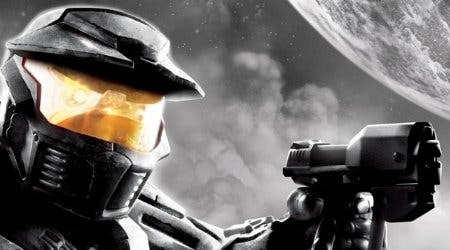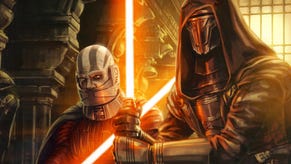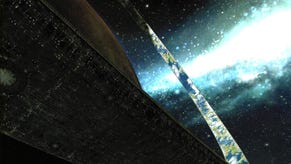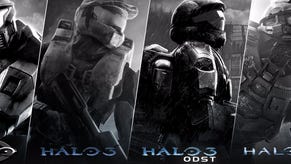Halo Anniversary: Returning to the Ring
Bringing a classic back to life, warts and all.
A decade is a long time in video games, and going back to Bungie's very first Halo game goes to shows how far we've come since 2001's Combat Evolved.
There's a pastel wash across the original's textures, an endearing naivety to its threadbare narrative and a raw simplicity to its gunplay that all speak of an era that seems so much further away than it really is. It's a relic, but it's a fairly youthful one.
And, in Halo Anniversary, ten year's worth of progress is condensed onto one button, with a simple press swapping out the original's visuals for a sparkier, more cluttered world.
It certainly looks good enough to rub shoulders with the shooter class of 2011, even if it's missing some of the loud-mouthed bombast of Call of Duty and Battlefield.
Play Halo Anniversary on a hulking 3D TV in surround sound and it even seems like Combat Evolved has found its true home - plasma grenades sparkle with furious fidelity, while the alien worlds are brought to vivid life as the matte skybox of the original now shimmers with detail.
It's a remake, but it's one of a very different order to the recent HD ports of Bluepoint Games on the PlayStation 3 - a curious tangle of old and new that's both faithful to the original whilst managing to reimagine it completely.
And as a collaborative effort between Saber Interactive, 343 Industries and Certain Affinity, it's a unique achievement. Here, producer Dennis Ries takes us through Halo Anniversary, the challenges it presented and its controversial Kinect implementation.
Well, we say it's been ten years in the making. But as far as work on this one goes, it's probably been a year and a half to two years. As long as two years ago we really started talking about a remake, and it was very challenging to know how to do this because we knew we wanted to stay true to the classic gameplay - and how to do that took a lot of effort. We went on a partner search to find someone to do that, and that's when we found Saber.
One of the things about Saber is that they're a great tech house. We sat and we met with them and they had a great solution, which really allowed us to use the existing game code with their updated graphics and audio, and it gave us the best of both worlds.

No, it was something they had to put together for this game.
Not always the plan, but when we sat down and started talking about it we started talking about how we'd use the existing game engine and improve it. But after we went through all the [potential] partners, Saber came up with the most elegant solution.
Where we could we used assets from Halo 3 or Reach, but when there weren't any available it was 343 working with Saber for the campaign. Obviously for the multiplayer it was Certain Affinity [the studio behind Reach's most recent multiplayer maps] but we had the same art director on both so you have the same feel, even though they're both completely different.
Well, we're reaching that ten-year mark, and oftentimes it becomes the tailend of a console era - and you end up with a great combination of this developed IP and people trying to figure out how to keep it alive, and how to keep it interesting. It's been something the fans have wanted for a long time, and they've been asking for it since the launch of Halo 2 - it's funny, we've been searching for the right time, and with the Anniversary and with Halo fest and all these great things happening, we thought now's the best time.
"There were times when we contemplated tinkering, but we really wanted to keep this game, warts and all, as it was."
Well, you think about continuity of the franchise and making sure that you don't change things too much, and staying true to what the original was. Without speaking for whether or not Star Wars was good or bad or how they did the remakes, from our perspective one of the things that was important to us was making sure we stayed true to what it was ten years ago.
So even now with the fiction, Kevin Grace and Frank O'Connor who overlook the fiction of the franchise were really involved with the terminal videos, so that they're inline with the books that are coming out. We tried to make sure we had real continuity there.
In my perspective, it would be the version that you like best. What I love about this version is that you can flip back to the original and see what it looked like ten years ago. When we started looking at the remastered version, we knew gameplay would hold up, so it came down to the graphics. We knew there were going to be decisions we would make that some of the hardcore fans maybe wouldn't like. And that's why we have something like classic mode available.
It was - there were times when we contemplated it, but we really wanted to keep this game, warts and all, as it was. It was tempting, but we made sure not to do that, so people could relive that magic.
So things like sandbox animations, all of that remains the same. It's a little weird, because you'll see animations in the sandbox from ten years ago, and it feels a little unnatural at first. So yeah, I don't know if that's a lagginess, but I do understand there's a weirdness to it. I think that users will see that playing in the original mode is like it was 10 years ago.

We're not really talking about anything in the future. We're happy with the tech and what it's done for the campaign. We're not talking about Halo 2, but anything's possible.
You'll see a lot around the multiplayer space - we've spoken a bit about the title update we're doing, and you're going to see some things throw back so there'll be some changes to the pistol.
As we mentioned if you pay attention to the Terminal videos you can find some information on what's to come in Halo 4.
"I can see [that people might be upset] but I think we were able to mitigate a lot of that as we didn't really take away from people who didn't buy Kinect."
So we're not talking about Halo 4 - but we are encouraging people to go and check this stuff out.
Really there's two major components of Kinect - one being the voice integration, so you'll be able to say grenade to throw your grenade, or even reload - and also there's analyse. If you say analyse, you get a filter on the screen to see what objects in the world you can analyse. Once you do you can scan these objects and scan them to the Library. Here you'll be able to look at a lot of the fiction and details around what those assets are - so it becomes something of a collector's game.
One of the things we did was make sure that there are no achievements associated with Kinect. From a production standpoint, Kinect made it very easy for us to do voice integration. So that seemed like the best way to go. As far as the content goes, it is all available online.
Yes, you can get it all on Waypoint. Yes, I can see [that people might be upset] but I think we were able to mitigate a lot of that as we didn't really take away from people who didn't buy Kinect. If you have Kinect, it's a great feature. Similar with the 3D stuff - if you have a 3D TV, you're going to use it.
Honestly, I don't know - I hope a lot. I think it's a fun feature - it's one of the features that is kind of surprising. At first I didn't know what to think of it, but it's a lot of fun.
From our perspective it was important for Halo Anniversary to not disrupt the core gameplay, as that's been our pillar the entire time. So we looked at it being additive - how could we enhance the core gameplay without changing it?
Well, you know we're not really talking about those right now!









